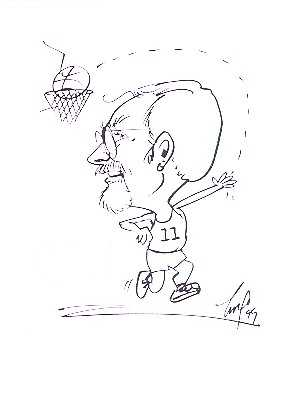Pine Time
The Memorial Day holiday has kept me off the court all weekend, so I've been enjoying watching the NBA play-offs instead. These conference championships are often the best games over-all, since the teams tend to know each other pretty well, and rivalries are intense. As I said before, I don't really have a "favorite" this year...although I do find myself rooting for the Heat -- a nice mix of experienced veterans and a talented young Dwayne Wade, plus a coach who knows what it takes to win Championships. And I've always been a big fan of the Glove -- delighted to see GP play so well in Game One of that series, and to continue to play strong "D" and make big shots in the last three games as well.
Knowing how to keep your head in the game when your butt is on the bench is a very useful skill to develop. It gives you a chance to cultivate your powers of Observation, Recognition, and even Decision-making without any of the pressures of actual performance. Plus you get to see what both your teammates and your opponents can actually do as well (without any worries about having to do it with them or having it done to you), which makes it a lot easier to play together when you DO finally get on the floor. Anticipation can make us seem quicker even when we've lost a step or two; I often know what the player I'm guarding is going to do before he even knows it himself, which allows me to be there waiting for him. Obviously, the map is not the territory -- some things can only be learned by doing. But I will say this: the better you know the contents of the map in your mind, the easier it is to navigate the territory on foot.
There's a certain pleasure simply to appreciating the beauty of the game from a distance: to seeing it as pattern and a performance rather than an event requiring that you participate and perform as well. Of course, there's also a danger to developing this capacity TOO well. Don't EVER want to get caught standing around "watching the paint dry" when you ought to be making a play. So get it out of your system WHILE you're sitting on the bench, so you won't ever be merely an observer on the floor.
Have you ever noticed how some of the most successful coaches -- Phil Jackson, Pat Riley, Larry Brown to mention three of my favorites -- were players who spent a lot of their playing days on the bench? Not to slight their talents, but there's something about sitting on the bench watching and figuring out how to keep up with guys who are bigger, faster, taller and more talented than you that gives a player a different kind of mentality, and turns them into both students and teachers of the game. Or at least that's my theory. Well, one of them at least....


